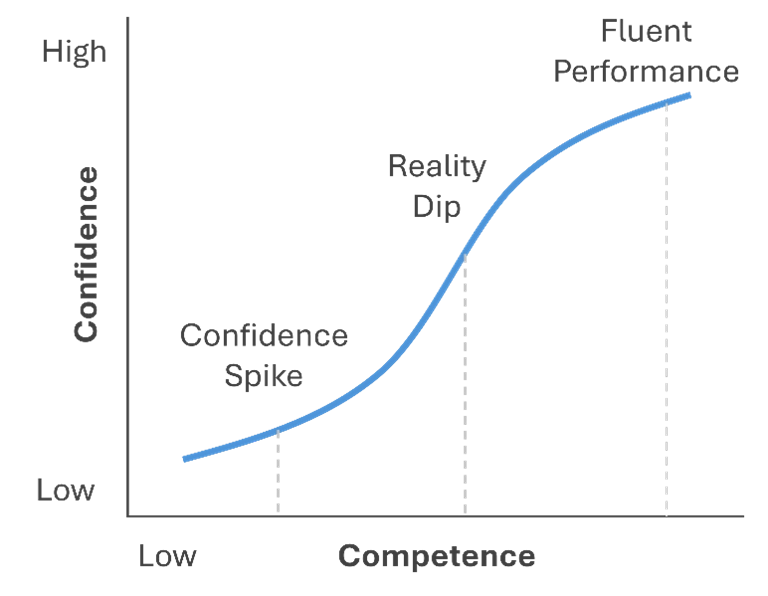The confidence curve: measuring what truly predicts readiness
It's 9:10 a.m. in Dublin, and Sofia, a senior account manager for a global tech firm, is about to lead a client call. She's been through all the training—objection handling, solution framing, consultative questioning. She's passed every assessment with ease.
But as she watches the client join the Zoom call, her confidence flickers. What if they push back on pricing again? What if she can't recall the new messaging guidelines?
The training gave her the knowledge of what to say. But in this moment, she needs something different—the belief that she can say it well.
Her competence is solid. Her confidence is uncertain.
That invisible gap—between what employees know and what they trust themselves to do—has always been the hardest part of learning to measure. Until now.
The two better c's: why competence alone doesn't guarantee performance
For years, L&D has measured what's easiest to count—course completions, quiz scores, attendance. But as explored in From "completions" to the two better C's, these metrics tell only half the story. True performance emerges when competence and confidence rise together.
Competence answers, Can I do this?* *Confidence answers, Will I do this—under pressure, in real time, when it matters?
They are distinct but intertwined forces. Competence without confidence leads to hesitation—employees who know what to do but doubt themselves when the stakes rise. Confidence without competence produces false assurance—employees who act decisively but incorrectly.
The goal of learning isn't to maximize one; it's to synchronize both. And now, for the first time, AI makes confidence measurable—so it can be developed intentionally, not left to chance.
Why confidence is the missing metric
Traditional LMS data—time spent, scores, completions—offers no insight into confidence. At best, it measures what people know, not how ready they are to use it.
Confidence was long dismissed as too subjective to quantify. But AI-powered microlearning platforms like Surge9 capture the behavioral and emotional signals that reveal confidence in action. They measure not just what learners get right, but how they feel as they do it—transforming self-belief into a form of learning data.
How surge9 measures confidence
Speed and Certainty: Fast, consistent responses on familiar topics indicate confidence. Hesitation or double-checking reflects uncertainty. Surge9's AI detects these patterns to map how assurance grows alongside accuracy.
Calibration Accuracy: Confidence isn't about being sure—it's about being accurately sure. Surge9 compares self-rated confidence to actual correctness, creating a "calibration index." Overconfidence and underconfidence both become visible, coachable behaviors.
Emotional and Linguistic Cues: As explored in The science of feeling understood, emotion shapes learning as much as cognition. Surge9 uses voice and language analysis to detect hesitation, tone shifts, or uncertainty—allowing feedback to respond empathetically in real time.
Resilience Under Challenge: Learning that's slightly challenging strengthens both competence and confidence. Surge9 measures how learners respond to increasing difficulty—do they persist, pause, or disengage? Confidence becomes observable as resilience.
Transfer to Real-World Scenarios: In AI-scored simulations, learners explain reasoning, defend choices, and role-play complex interactions. The AI evaluates not just correctness, but conviction—the strength and consistency of the learner's belief in their own response.
The confidence–competence curve
Confidence and competence evolve together—but rarely in lockstep. We visualizes this relationship through the Confidence–Competence Curve.

At the Confidence Spike, early exposure makes learners feel capable before real mastery forms. Then comes the Reality Dip, when deeper practice exposes complexity and confidence temporarily drops. Finally, learners reach Fluent Performance, where capability and assurance rise together—true readiness for real-world performance.
This curve helps L&D teams see readiness more clearly. It reveals who needs encouragement to regain self-belief, who may be overconfident despite low accuracy, and who has reached the balanced fluency where performance takes off.
From data to development
Traditional learning systems tracked completions. Surge9 tracks belief. Its AI transforms micro-behaviors—response times, self-assessments, tone analysis—into actionable intelligence for both learners and leaders.
Learners get personalized feedback loops that strengthen confidence through practice and reflection. Leaders get dashboards that show where assurance dips, where competence outpaces confidence, and where targeted reinforcement can restore balance.
The result: organizations can finally develop confidence as systematically as they build skills.
Why it matters
Sofia's story isn't unusual. Across industries, employees are more informed than ever—but still hesitate when it matters. The most common learning gap today isn't ignorance; it's uncertainty.
As Transforming potential into performance explains, the bridge between knowing and doing is built on confidence. When L&D can measure that bridge, it can finally strengthen it—turning analytics into assurance and information into readiness.
Confidence isn't fluff. It's the multiplier that transforms knowledge into performance.
The new equation for readiness
The future of learning won't be driven by completion data. It will be powered by readiness data.
C² = P
Competence × Confidence = Performance
Surge9 makes both measurable—and both improvable—turning learning into a continuous readiness engine.
Because when people not only know what to do but believe they can do it, performance doesn't just improve—it accelerates.
Turn confidence into your competitive advantage
See how Surge9 measures and develops confidence alongside competence to accelerate performance.